
Final Fantasy Mystic Quest, released as Mystic Quest Legend in PAL regions and as Final Fantasy USA: Mystic Quest in Japan, is a role-playing video game for the Super Nintendo Entertainment System. It was released as a spin-off to Square's Final Fantasy series of video games. Final Fantasy Mystic Quest was first released in North America in 1992 and marketed as a "simplified role-playing game... designed for the entry-level player" in an attempt to broaden the genre's appeal. The game's presentation and battle system is broadly similar to that of the main series, but differs in its inclusion of action-adventure game elements. It was also the first Final Fantasy game to be released in Europe.

Phantasy Star is a role-playing video game (RPG) developed by Sega and released for the Master System in 1987. One of the earliest Japanese RPGs for consoles, Phantasy Star tells the story of Alis on her journey to defeat the evil ruler of her star system, King Lassic, after her brother dies at his hands. She traverses between planets, gathering a party of fighters and collecting the items she needs to avenge her brother's death and return peace to the star system. The gameplay features traditional Japanese RPG elements including random encounters and experience points. All the characters have predefined personalities and abilities, a unique element compared to the customizable characters of other RPGs of the era.

Pool of Radiance is a role-playing video game developed and published by Strategic Simulations, Inc (SSI) in 1988. It was the first adaptation of TSR's Advanced Dungeons & Dragons (AD&D) fantasy role-playing game for home computers, becoming the first episode in a four-part series of D&D computer adventure games. The other games in the "Gold Box" series used the game engine pioneered in Pool of Radiance, as did later D&D titles such as the Neverwinter Nights online game. Pool of Radiance takes place in the Forgotten Realms fantasy setting, with the action centered in and around the port city of Phlan.

Ehrgeiz, fully titled Ehrgeiz: God Bless the Ring, is a 3D fighting video game developed by DreamFactory and published by Namco in 1998 for the arcade platform. It was first ported to the PlayStation and published by Square Co. in 1998, then to Japan's PlayStation Network by Square Enix in 2008.

Wonder Boy in Monster Land, known by its original arcade release as Wonder Boy: Monster Land, is a platform video game developed by Westone Bit Entertainment and released by Sega in Japanese arcades in 1987 and for the Master System in 1988, with a number of other home computer and console ports following. The game is the sequel to the 1986 game Wonder Boy and takes place eleven years after the events in the previous game. After enjoying over a decade of peace on Wonder Land following the defeat of the evil King by Tom-Tom, later bestowed the title "Wonder Boy", a fire-breathing dragon called the MEKA dragon appeared; he and his minions conquered Wonder Land, turning it into "Monster Land". The people, helpless due to their lack of fighting skill, call for Wonder Boy, now a teenager, to destroy the monsters and defeat the MEKA dragon. Players control Wonder Boy through twelve linear levels as he makes his way through Monster Land to find and defeat the MEKA dragon. Players earn gold by defeating enemies and buy weapons, armor, footwear, magic, and other items to help along the way.
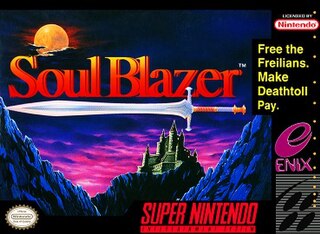
Soul Blazer, released in Japan as Soul Blader, is an action role-playing video game developed by Quintet and published by Enix for the Super Nintendo Entertainment System. It was released in 1992 in Japan and North America, but not released in Europe until 1994.
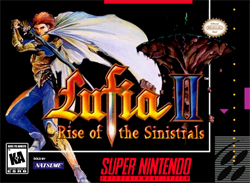
Lufia II: Rise of the Sinistrals, known as Estpolis Denki II in Japan, and as Lufia in Europe and Australia, is a role-playing video game with puzzle elements developed by Neverland and published in Japan in 1995 by Taito, and in North America and Europe in 1996 by Natsume and Nintendo respectively, for the Super Nintendo Entertainment System. It is the second game in the Lufia series.
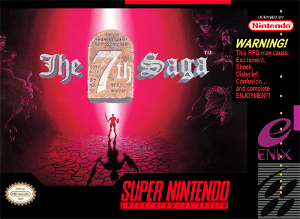
The 7th Saga is a turn-based role-playing video game developed by Produce! and published by Enix for the Super Nintendo Entertainment System in 1993. The game made innovative use of a radar system during gameplay. It featured 7 playable characters of various types including humans, an elf, a dwarf, robots, a demon, and an alien. Each character has unique items and spells.
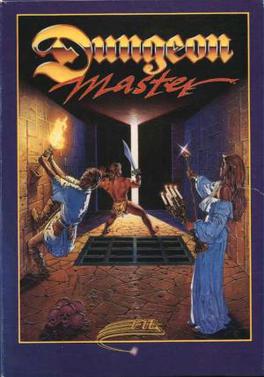
Dungeon Master is a role-playing video game featuring a pseudo-3D first-person perspective. It was developed and published by FTL Games for the Atari ST in 1987, almost identical Amiga and PC (DOS) ports following in 1988 and 1992.

The Bard's Tale II: The Destiny Knight is a fantasy role-playing video game created by Interplay Productions in 1986. It is the first sequel to The Bard's Tale, and the last game of the series that was designed and programmed by Michael Cranford.

Champions of Norrath: Realms of EverQuest is an action role-playing video game for the PlayStation 2, set in the EverQuest universe. The game is playable with one single player or cooperative for up to four players, but with a Network Adapter, players can take the game online with others and kill others or join to form groups of adventurers. It uses a re-worked and expanded Baldur's Gate: Dark Alliance game engine. A sequel called Champions: Return to Arms was released in February 2005.

Dungeons & Dragons: Shadow over Mystara is an arcade game developed and published by Capcom in 1996 as a sequel to Dungeons & Dragons: Tower of Doom. The game is set in the Dungeons & Dragons campaign setting of Mystara.

Torneko: The Last Hope is a 1999 role-playing video game for the PlayStation. The game was co-developed by Chunsoft and Matrix Software and published by Enix. In Japan, the game was ported to the Game Boy Advance in 2001.

Lufia & the Fortress of Doom, known as Estpolis Denki in Japan, is a role-playing video game developed by Neverland and published by Taito in 1993, for the Super Nintendo Entertainment System. It is the first title in the Lufia series of video games and the only game from the series released under the Taito label in North America.

Wonder Boy in Monster World, known in Japan as Wonder Boy V: Monster World III, is a side-scrolling action role-playing game originally developed by Westone and published by Sega for the Mega Drive/Genesis in 1991. It is the fifth game in the Wonder Boy series and the third game in the Monster World sub-series, following Wonder Boy in Monster Land and Wonder Boy III: The Dragon's Trap.
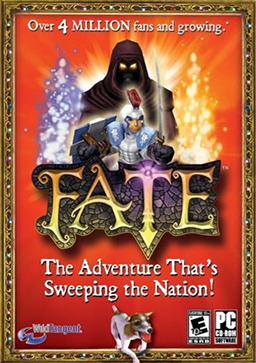
Fate is a 2005 single-player action role-playing game originally released for the PC by WildTangent. Fate was released for the PC Steam client on December 12, 2013. Three sequels—titled Fate: Undiscovered Realms, Fate: The Traitor Soul and Fate: The Cursed King—were released in 2008, 2009 and 2011 respectively.
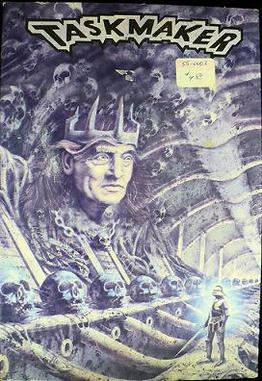
TaskMaker is a role-playing video game for the Macintosh. It was developed by American software company Storm Impact. Originally published in 1989 by XOR Corporation, it was upgraded and re-released as shareware in 1993 by Storm Impact, featuring color graphics and compatibility with newer versions of the classic Mac OS. The player controls a protagonist who is under the mentorship of the eponymous TaskMaker, a ruler who assigns ten different quests. Completing these quests involves solving various gameplay puzzles, along with battling monsters, and the final task involves a battle against the TaskMaker himself. TaskMaker received mixed reception regarding its overall storyline and gameplay.

Tales of the World: Radiant Mythology is a Japanese action role-playing game developed by Alfa System and published by Bandai Namco Games. It is part of the Tales series of video games, more specifically a part of the Tales of the World spin-off series, which heavily emphasizes the crossover appearances of characters from past games in the series. The game was released in 2006 in Asia; July 2007 in North America; and September 2007 in Australia and Europe. The game saw two sequels, Radiant Mythology 2 and Radiant Mythology 3, though neither were released outside Japan, leaving it as the only Tales of the World entry to be translated into English.

The Nightmare of Druaga: Fushigi no Dungeon is a roguelike video game developed by Arika, Matrix Software, and Chunsoft, published in 2004 in Japan by Arika and in North America by Namco Hometek exclusively for the PlayStation 2. It is a sequel to The Tower of Druaga and the eighth game in Chunsoft's Mystery Dungeon series.

Dungeon Siege III is an action role-playing game developed by Obsidian Entertainment. It was published by Square Enix for PlayStation 3, Xbox 360 and Microsoft Windows in June 2011. It is the third full and fifth overall release in the Dungeon Siege series of video games and the first since Dungeon Siege: Throne of Agony in 2006. The game is set in the pseudo-medieval kingdom of Ehb, 150 years after the events of Dungeon Siege and follows descendants of survivors of the 10th Legion in their quest to reestablish their military force.





















